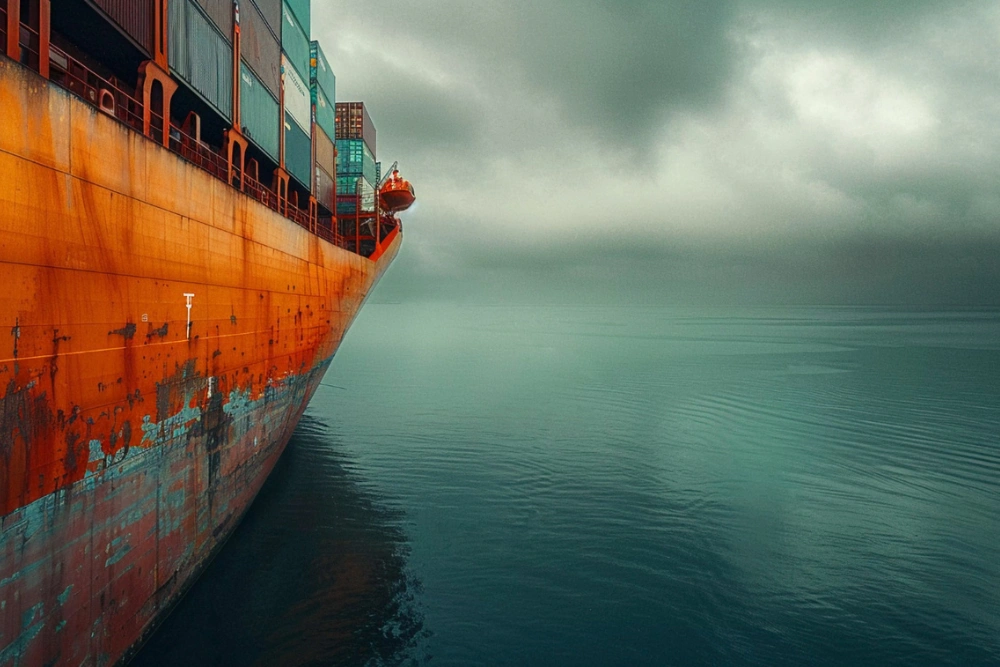Sea freight forwarding sounds simple, but it’s full of surprises — from missing containers and rising shipping costs to customs delays and cyber threats. This blog breaks down the top challenges in sea freight and freight forwarding, especially in the UAE, and shows how smart companies are handling them. Whether you’re new to logistics or deep in the industry, you’ll find practical tips and real solutions here.
- Key Takeaways
- 1. Container Shortages Are Still a Big Deal
- 2. Freight Costs Keep Rising — and Changing Fast
- 3. Port Congestion Slows Everything Down
- 4. Customs Rules Can Get Complicated
- 5. You Can’t Fix What You Can’t See
- 6. Politics and Trade Wars Can Change the Game
- 7. Cargo Theft and Security Risks
- 8. Cyber Threats Are Growing in Shipping Too
- 9. There’s a Shortage of Skilled Shipping Workers
- 10. Tech Adoption Isn’t Always Easy
- Quick Look — Sea Freight Challenges and How to Tackle Them
- FAQs
- What are the main challenges of freight forwarding in the UAE?
- What are the disadvantages of sea freight transportation?
- What are the current challenges in the container shipping industry?
- How can businesses overcome ocean freight challenges effectively?
- Need Help Navigating Sea Freight Challenges?
Key Takeaways
- Sea freight forwarding faces major issues like capacity shortages, fluctuating freight rates, and port congestion, which can lead to missed deadlines and rising costs.
- In the UAE, freight forwarders deal with unique hurdles like regulatory compliance, customs clearance delays, and high operational costs that can slow things down.
- To overcome these challenges in freight forwarding, smart companies are using tech tools, building better networks, and working closely with ocean freight forwarders to stay on track.
Let’s walk through some of the top challenges in freight forwarding, why they happen, and what smart companies are doing about them.
1. Container Shortages Are Still a Big Deal
There just aren’t enough containers to go around. Sometimes your cargo is ready, but there’s no container to put it in. Other times, they’re sitting in the wrong country altogether.
Why it happens: Containers don’t travel on their own. If they’re stuck in places with low demand, they pile up. And during demand spikes, it’s hard to get your hands on one.
Smart move: Companies are pre-booking containers early or leasing them. Flexibility helps tackle one of the biggest challenges of the container shipping industry.
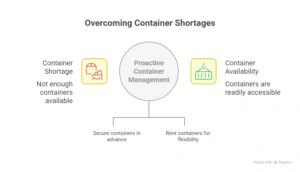
2. Freight Costs Keep Rising — and Changing Fast
If you’re trying to budget shipping costs, good luck. One week it’s $2,000, the next it’s $10,000.
Why it happens: Rates go up due to fuel prices, strikes, new regulations, or capacity issues — classic problems with sea freight transportation.
Smart move: Lock in rates with long-term partners. Some freight forwarding companies in the UAE offer contracts to avoid these swings.
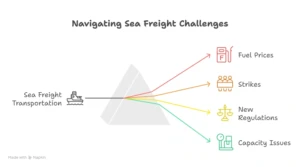
3. Port Congestion Slows Everything Down
Imagine hundreds of ships in line to unload. Even if your shipment arrives on time, it might just sit there.
Why it happens: Too many vessels, not enough staff. Weather, strikes, or tech issues can clog things up — a common challenge in shipping industry operations.
Smart move: Use smaller or alternate ports. Some freight forwarders in Dubai now offer real-time updates to help you reroute on the fly.
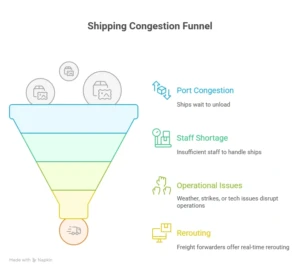
4. Customs Rules Can Get Complicated
One tiny paperwork mistake? Your shipment is stuck. Worse, it might get fined.
Why it happens: Each country has different rules. And they change often, especially in regions like the UAE.
Smart move: Work with pros who know the rules. Many freight forwarding companies in UAE now use digital customs platforms to reduce errors and delays — an effective way of overcoming ocean freight challenges.
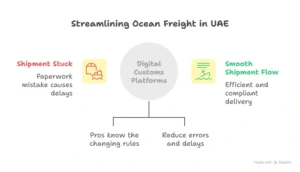
5. You Can’t Fix What You Can’t See
No updates. No location data. No clue where your cargo is.
Why it happens: Older tracking systems and poor communication. Not knowing creates missed deadlines and frustrated clients — one of the biggest sea freight challenges.
Smart move: GPS and freight tracking tools now show live updates. Think Google Maps, but for containers.
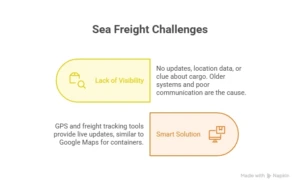
6. Politics and Trade Wars Can Change the Game
Suddenly, a country bans imports. Or raises a tax. These shifts can cause chaos.
Why it happens: Sanctions, trade restrictions, and political instability — especially for companies shipping globally. It’s one of the more unpredictable challenges in sea freight shipping.
Smart move: Spread out your supply chain. Many freight forwarders in the UAE help companies prepare backup routes and strategies.
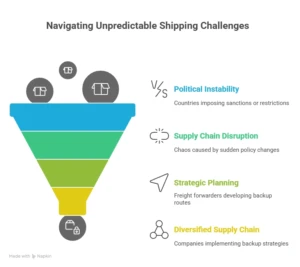
7. Cargo Theft and Security Risks
Unfortunately, stolen or tampered cargo is a thing — and it hits your bottom line hard.
Why it happens: Poor security, weak seals, and even insider jobs.
Smart move: Use tamper-proof seals, trusted carriers, and insurance. Many UAE freight forwarding and logistics teams are stepping up their safety measures.
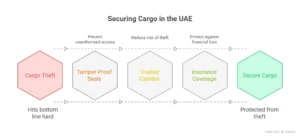
8. Cyber Threats Are Growing in Shipping Too
Hackers love outdated systems. One click can crash your entire operation.
Why it happens: Weak passwords, outdated platforms, and untrained staff open the door.
Smart move: Regular cyber audits and staff training help reduce these risks. Top sea freight forwarding companies in Dubai take this seriously.
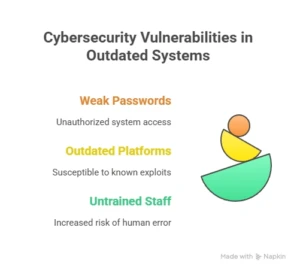
9. There’s a Shortage of Skilled Shipping Workers
Experienced staff are getting harder to find — and it shows.
Why it happens: Fewer young people are joining the industry, and older staff are retiring. That’s leading to a real challenge in freight forwarding in UAE and beyond.
Smart move: Train your team. Automate simple tasks. And don’t be afraid to outsource during crunch time.
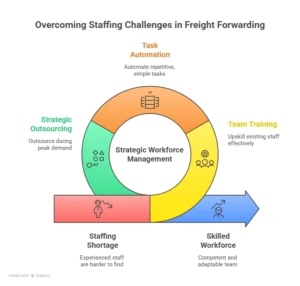
10. Tech Adoption Isn’t Always Easy
Lots of companies still run on spreadsheets. Or fax machines. No joke.
Why it happens: Tech can feel overwhelming. And change can be hard — especially for older systems or teams.
Smart move: Start with small tools like digital tracking. Tech doesn’t have to be scary — and over time, it helps with nearly every challenge of sea freight forwarding.
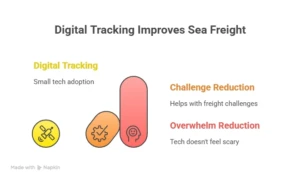
Quick Look — Sea Freight Challenges and How to Tackle Them
| Challenge | What’s the Issue? | Smart Solution |
| Container Shortage | Limited equipment availability globally | Pre-book containers, consider flexible leasing |
| Rising Freight Rates | Unpredictable price surges | Lock in rates, build long-term shipping contracts |
| Port Congestion | Vessel delays, unloading issues | Use alternate ports, real-time updates |
| Customs Complications | Changing regulations, documentation errors | Work with experienced agents, use digital tools |
| Lack of Visibility | Hard to track real-time cargo movement | Invest in GPS and freight tracking software |
| Geopolitical Issues | Sanctions, wars, changing trade policies | Diversify routes and suppliers, stay updated |
| Cargo Security | Theft, tampering, or mishandling | Use tamper-proof seals, insurance, verified carriers |
| Cyber Threats | Data breaches, ransomware, system downtime | Cyber audits, secure platforms, staff awareness |
| Labor Shortages | Fewer trained workers = delays and mistakes | Staff training, use automation and outsourcing |
| Tech Resistance | Manual processes still dominate | Start small with digital tools like AI scheduling |
FAQs
What are the main challenges of freight forwarding in the UAE?
Rising costs, customs delays, port congestion, and labor shortages are some of the biggest challenges in UAE freight forwarding and logistics. Many freight forwarders in Dubai now use tech and smarter planning to work around them.
What are the disadvantages of sea freight transportation?
Slower delivery, less flexibility than air freight, and risks like cargo damage, delays, and theft.
What are the current challenges in the container shipping industry?
Container shortages, price spikes, cyber threats, and global politics all add to the pressure.
How can businesses overcome ocean freight challenges effectively?
Plan early, work with experienced freight forwarders, use real-time tracking, and diversify your suppliers.
Need Help Navigating Sea Freight Challenges?
Whether you’re dealing with container delays, customs headaches, or rising freight costs, having the right partner makes a difference. Companies like Triroute, a trusted sea freight forwarding company in Dubai, help businesses simplify shipping and stay ahead of these problems with smarter tools and expert advice.


